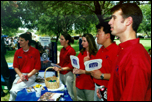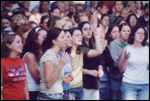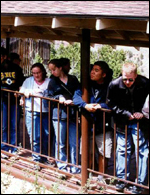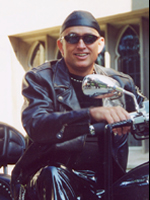 |
President Kenneth Hemphill throwing Frisbee with students during Southwestern Baptist Theological Seminary's annual spring picnic.
Photograph by Richard D. McCormack
|
The system was supposed to be simple. God anoints messengers who then seek seminaries to prepare them for service. The Almighty plants; the seminaries harvest. But while that basic two-step remains the rule, the process of actually locating the anointed and steering them toward schools of divinity has become murkier and not the least bit simple.
Recruiting those who feel summoned for theological education has required greater risks and evolving strategies. Not long ago, most seminaries essentially waited for candidates to waltz through the door. Now more and more of these schools must aggressively recruit. Often this means working both ends of the vocation equation: helping young people discover whether they have a call and making a pitch for their own institutions as superb choices for theological schooling.
Seminaries look to effective tactics to keep the numbers of students high enough. Congregations look to campuses and parishes to keep the idea of church vocation alive in order to keep their pulpits occupied. Denominational officials look to both vibrant local churches and strong seminaries to supply regional and national leadership.
The three theological schools reviewed here illustrate the wide array of distinctions in location, church affiliation, and real-life circumstances. All have faced dwindling enrollments. Two of them were, not long ago, fading fast; the third was worried. All have responded by raising the level of their active recruiting and searching for better methods of finding and fetching.
 |
Jason Greenwich, Bethany Cantrell, Jolene Crouch, Tim Byun, and David Taylor staff the Prospective Students Office table at Southwestern's annual church fair to welcome new students to campus.
Photograph by Don O. Thorpe
|
Southwestern Baptist Theological Seminary holds the unofficial title of the “world’s largest Protestant seminary” and the “most Texas” of all the Southern Baptist theological schools. Located in Fort Worth, Texas, it has approximately 3,300 students, which is impressive by most standards except Southwestern’s own. The total once reached as high as 4,000—with ease—but in recent years the numbers have dropped, causing concern. School officials are striving to re-ignite the growth spurt but aren’t sure just how to. “We haven’t had to think outside the box,” said David G. McQuitty, dean of students. “Either the spiritual life has flickered out or we haven’t done what we need to do.”
Aquinas Institute of Theology in St. Louis, Missouri, a Dominican institution on the grounds of Jesuit-run St. Louis University, had shrunk to around 100 students, including just fifty-five full-timers, most of them seminarians sent by religious orders, in the early 1990s. The Reverend Charles Bouchard, a Dominican priest who has served as president since, says “we couldn’t have continued unless we increased enrollment.” He took hold of the crisis, won a Lilly Endowment grant to develop strategies and, as a result, the school now registers more than 250 mostly Catholic students in a variety of programs.
Western Theological Seminary in Holland, Michigan, is where the Reformed Church in America does much of its thinking in the Midwest. But as recently as the mid-1990s, Western’s proud tradition was in jeopardy. When Dr. Dennis Voskuil took the reins as president in 1994, just ninety-four students were there to greet him. After a series of quick moves, including the enlistment of a faculty member with ace recruiting skills and Voskuil’s own marketing talents, fortunes were reversed. The next year’s entering class was fifty-nine. The trend has headed upward since.
Attracting students is, of course, expensive and presses the already strapped resources of seminaries, though doing nothing would cost far more. Moreover, the casting of nets involves a complex cluster of talents and functions, sometimes entailing the hiring of new personnel and borrowing faculty and administrators part time, taking slices from a variety of in-house budgets as well as depending on volunteers. Of the three seminaries here, Aquinas has the simplest solution, at least in the short term, because of a $1.5 million five-year Lilly grant it received for that purpose in 1998. The challenge to find the funds from within lies ahead. Southwestern and Western, with histories of sound fiscal management, have so far been able to keep pace with the rising recruitment costs.
Shared Challenges
 |
Students at Hope College, adjacent to Western Theological Seminary, fill the air with praise at an outside chapel service. Western professor Tim Brown serves dual roles by leading Hope's chapel staff, whose ranks include a 2002 Western graduate as chaplain and two current students as interns.
Photograph by Brenda Brewer
|
Despite the great differences that characterize them, the three seminaries share a remarkable degree of similarity in facing down the recruiting challenge. Among them:
-
All have stepped up their level of personnel, money, time, and effort into finding and fetching new students. Southwestern has restructured its admission department and recently beefed up the core of student recruiters. Aquinas has hired its first full time admissions officer who engages all administrators in recruiting. Western, likewise, has its first full-time recruiter who also coordinates promotional activities with other officials. Aquinas received the Lilly grant to help the process along; the others have financed the initiatives themselves.
-
The three schools search new and old vineyards with renewed intensity. Aquinas’s success hinges largely on the appeal of its lay ministry program. That means, among other things, close contact with parishes and schools to find potential students. Western finds sources at colleges related to its denomination (Hope, Northwestern College, Central) but has to work harder to identify them. Southwestern has relied increasingly on inviting prospective students to visit the campus. Two-thirds of those who visit eventually apply (Western also uses this to good effect).
-
The campus, the campus, the campus. The three most important words in recruitment. Recruiters say that’s where the action is. “The churches no longer form vocations,” said Dr. Robert Van Voorst, a theologian at Western. “The campus does.” Echoes of this sentiment are found on all three seminaries. Campus ministries and the activities such as InterVarsity Christian Fellowship and Campus Crusade for Christ have, in the view of officials of the three schools, caught fire in recent years, resulting in revival. According to this understanding, young people with little or no experience in the church have been attracted to campus Christianity in growing numbers. Among them, the seminaries have found vocations. Aquinas is in close touch with twenty-two colleges and universities. Western beats a regular path to its church-related campuses. Southwestern recruits at Baptist colleges and beyond to many major secular universities such as Texas A & M.
-
Targeting Generation X. Not everyone believes such a cohort actually exists, but those who do define Gen-Xers roughly as those born between 1964 and 1981, many of whose families split up. Depending on the source, they get often pegged variously as slackers and cynics or sensitive souls attuned to others’ grief because of their own brokenness. Whatever the definition, Gen-X is a reality that has worked its way into the admissions vocabulary and strategy. Southwestern takes note of the alleged Gen-X affinity for the visual over print by sending out CD-ROMs instead of paper catalogues. Western attempts to provide a strong sense of community to overcome alleged Gen-X wariness and apathy. “Gen-Xers,” said Dr. James Brownson, Western’s academic dean, “are looking for a place to belong.” Aquinas takes young people on “Ministry in the Mountains” retreats in Colorado to fill in gaps in their knowledge of the church.
Religious Maturity Postponed
-
Demographics. The specter of divorce and family disruption has affected younger seminarians arriving in all three schools. Family break-up—and the whirligig of a go-go society—can upset patterns of church going and postpone religious maturity, placing more responsibility on seminaries to provide basic Christian education and, in effect, a church home.
Now for a closer look at how each theological school has met the challenge.
 |
In Colorado's mountains, Aquinas students are encouraged to examine how their story and God's story are intertwined.
Photograph by Jonathan Sullivan
|
Nothing compares in size or complexity with the spiritually robust Southwestern. The central building, an imposing yellow and white edifice in the Greek revival tradition, fronted by four thick columns, projects a message of solidity and influence. Inside, a majestic rotunda draws the eye upward in inspiration.
The school goes back nearly a century, to 1905, originally founded as a part of Baylor University, becoming independent four years later, and moving to Fort Worth shortly after. From the first, the school produced a steady stream of preachers, mostly from Texas. More than two out of five students still come from the state. The school claims 61,000 graduates.
But despite its impressive resources and vibrant spirit, there are cracks in the façade that are unlikely to pose threats to Southwestern but do challenge the seminary to shift certain directions.
Student registration peaked in the 1970s at 4,000 and remained strong. Recently, however, the supply of students has been dwindling. In the fall of 2000, 614 students registered; a year later, the number dropped to 540. Applications had declined accordingly, from 930 to 804. That has officials fretting.
Fractious Theological Disputes
In part, the slump reflects the fractious theological disputes within the Southern Baptist Convention. Southwestern, its governing board accountable to the national convention, has staked out an implacable fundamentalist position in a struggle with the moderates who dominate Texas Baptist affairs. The Baptist General Convention of Texas last year decided to throw its monetary support to moderate seminaries that compete with Southwestern and that has hurt recruitment.
But Southwestern’s recruitment team believes other factors are also in play. Preachers, especially graduates of the school, could do more to encourage young people for the ministry, they say. It is the lifeblood of the seminary: nearly 80 percent of the students are under age 30. “The faculty feels there’s been a slackening in the local church,” said Judy Morris, associate dean of enrollment services. “They’re not preaching for the call, asking whether God has called you.” Another problem they noted is Southwestern’s failure to keep up with the gadgetry necessary to reach today’s technologically savvy students. “We’re heading toward things we’ve never faced before,” Morris said.
The Need to Go Global
Likewise, though the seminary president, Kenneth Hemphill, has called for efforts to draw non-Baptist students, the methods for making significant headway are not yet in place. Implied in this process is a plunge into a global market, a direction that officials recognize could be fraught with implications for theological and cultural diversity. “We’ve been a denominational seminary,” McQuitty said, “now we must be global. We’re learning.”
 |
Western Theological Seminary's Tim Brown revs up youthful enthusiasm as he arrives decked out for a special theme chapel service at Hope College.
Photograph by Shane Sterk
|
As things stand, Southwestern has made some adjustments. Five years ago, as patterns looked less hopeful, the school expanded its cadre of “Ambassadors,” students trained to track down potential recruits. Numbering from twelve to twenty, these student-recruiters act as a ready deployment team for use in a variety of settings, singly or in small groups. Faculty are also being pressed into duty. The recruiters prowl campuses, youth evangelism meetings, and state Baptist conventions for possibilities.
Success is largely a function of scaring up enough interest to get prospects to spend a weekend on the beautifully manicured campus. Given the fact that two-thirds of those who visit will apply, the school goes all out to welcome and inform them. Altogether, McQuitty said, the seminary spends $400 on each visiting prospect.
The school is also doing more research into reasons why students enroll. The latest results, for example, show that they were influenced most often by pastors (22 percent) and friends (19 percent); that 90 percent had visited the school’s web site; that 75 percent had never seen a magazine ad for Southwestern and that nearly two-thirds (63 percent) were active in a college campus ministry. Most students said they were led to seminary by a “definite call from God” and for an “opportunity for study and growth.”
Re-Thinking the Basics
Even at Southwestern, the picture of stability and certainty, the shifts in climate have caused officials to re-think their basic approaches. In the past, the school knew pretty much whom to expect and what to expect from them.
“I used to think of this as a finishing school,” McQuitty said. “Now I think of it as a finding place.”
Training for Lay Ministry
A top executive in a large insurance company told Ron Knapp, Aquinas’s admissions director, that he had “an inkling, a nudge” that God has something in mind for him in a ministry. He could retire early, but should he do it? The idea sounded right but there was a catch. Would his pals in the business world respect him for going that way? Would they get it? It was a matter of downward mobility and he wasn’t sure he could risk his reputation. After several conversations with him, Knapp felt he was “on the cusp” of making a decision.
The executive’s dilemma highlights the difficulty of Aquinas’s unusual mission. Not only does the seminary continue to educate three dozen or so seminarians from religious orders but, in a bold step to survive, it took on the formidable task of training candidates for a whole new range of lay ministries opening in the Roman Catholic Church. For the insurance executive and others, the steps leading to a decision can be complex and arduous. Both the personal decision and the job description can be hard to figure out compared to the traditional vocations of nun and priest. Not only is it necessary to sort out one’s personal call, but also to grasp what the role is to which a lay person can aspire.
A generation ago, the concept of lay ministers was unknown to most Catholics. As the priest shortage grows more severe, non-ordained, paid members of parish staffs have become widespread and the demand for them grows. Still, many Catholics have only a dim idea what the role entails or what kind of training goes into it.
Official Catholic policy hasn’t helped. Though the Second Vatican Council said with emphasis that all Catholics receive a call to holiness at their baptism, the Vatican has stressed repeatedly that the term “ministry” belongs properly only to the priesthood. In the face of growing parish vacancies and the increasing supply of trained laity, however, the distinction appears to have become largely overlooked.
Bouchard’s alarmed awareness that something had to be done to increase the number of seminary students if the school were to survive, led him to see the answer in the growth of trained lay ministry. Over the past eight years, the school has pushed ahead with a series of efforts to answer lay questions about ministry and to offer a variety of programs to equip them. The challenge is to find laity with those inklings and nudges and steer them toward Aquinas.
Fortunately, the seminary’s location at St. Louis University provides a significant impetus. One effective program that has drawn seekers is an ongoing series called “Taste and See.” Each is a twenty-five-minute part pep-talk about lay ministry followed by discussion and, it is hoped, a shared interests about serving the church. Recent topics, for example, included a talk on “Lay Formation and the Changing Face of the Church” and “Jesus and the Mission of the Church.” The school posts the series on its web site and notifies a network of parishes of upcoming dates and topics.
 |
Flag football is one of the activities hosted by Southwestern's Recreation Aerobics Center to provide social interaction for the seminary family.
Photograph by Richard D. McCormack
|
Most of those who have responded in recent years are “second-career” candidates. With a grant from Lilly, the school has attempted to attract more young people. Knapp, who has been at Aquinas for five years, is the school’s first full-time admissions director. With Bouchard, he has coordinated an approach aimed at young recruits that so far has had only limited success. A key strategy has been to urge twenty-two Catholic colleges and universities to identify potential lay ministers. Bouchard was surprised by a few responses. “Some were frankly puzzled by what we were asking them to do,” he said. “They said they weren’t into the Catholic thing.” He won some over by persuading them that by aiding in this way they could help fulfill Rome’s requirement to demonstrate “Catholic character.”
The Ministry in the Mountains was another tool for wooing young people. The gatherings in Colorado have explored ministry and what the church is about. The Aquinas staff also pays calls on its affiliated campuses in search of applicants.
The gains have been modest. According to Knapp, thirteen younger students (under 30) have entered Aquinas in the past three years. Bouchard said several of those had dropped out. But the process is in its infancy and has unusual stumbling blocks. “Until very recently we didn’t have a mission and strategies for younger students. Most think of the lay ministry as a volunteer thing.”
“Young people also feel pressure from their parents,” Knapp said. “One of our recent master of divinity graduates is going to work for the Diocese of Saginaw. Her mom wanted her to be successful and self-sufficient. The daughter had been to Northwestern University and graduated with a degree in speech pathology. In her senior year she considered the ministry and her mom about had a fit. Her parents were afraid she was giving up a toehold in society.
“Professional lay ministry is just not clear enough.”
Igniting Young People’s Passions
Voskuil walked across the Hope College campus, where he had taught church history, to Western and, with the help of key associates, helped rescue the seminary from perilous decline by igniting a youth movement.
Voskuil is given credit by the Western staff for much of the success in turning a trickle of admissions into a respectable flow and for boosting the enrollment by nearly half to its current level of 150.
One of his first moves was to persuade Tim Brown, pastor of a nearby Reformed church and a graduate of the school, to become professor of preaching. Brown became a crucial sparkplug, complementing Voskuil’s prodigious enthusiasm and, in addition to his preaching duties, volunteered to help recruit. There was no full-time admissions officer at the time. The year Brown arrived, just eleven new students enrolled.
The two leaders then helped fashion a mission that would appeal to younger people. Doing that, in the view of the leadership team, meant “selling” the school to the kind of Reformed Church members who had chosen Western in the past but more recently had picked Fuller or Trinity instead. A major focus was the yield from the three church-related colleges. Fortunately for Western, a religious revival gripped each campus to one degree or another. At Hope, for example, a Sunday night chapel service regularly draws 1,200 students, nearly half of the school’s enrollment, and the celebration often goes on for hours. Students were also flocking to mission trips to foreign countries that were available through various campus ministries. According to the research of Dr. James V. Brownson, Western’s academic dean, the three leading experiences that propelled young people into seminary were summer church camp, Bible study in college, and a mission trip.
Brown’s personal appeal and his exceptional preaching talents made him popular on the campus ministry circuit. Voskuil’s winsome qualities and his intellectual rigor made him no less popular. Western’s first full-time admissions director, Mark Poppen, coordinates their efforts; like Brown, he stepped into the seminary from the parish ministry.
In the academic year 1994-95, when the pair arrived, just sixty-seven master of divinity candidates attended Western. During this past year there were 116.
Moreover, half of Western’s students are under thirty. The median age is now twenty-eight.
A central element in Western’s mission has been to create the kind of spiritual home that the Gen-Xers are presumably looking for. “Generation X is looking for a place to belong,” Brownson said. “They seek people who are at ease with self-disclosure, who can be authentic.” Western labors to provide that kind of open setting. That has been a large factor in the hiring of professors. Half the faculty positions have been filled since Voskuil arrived. “This seminary has a strong sense of community,” Voskuil said. “It is one thing that Gen-Xers value. Many have come from broken homes and fractured relationships.”
What potential seminarians look for, he has concluded, could be summed up simply: “passion and integrity.”